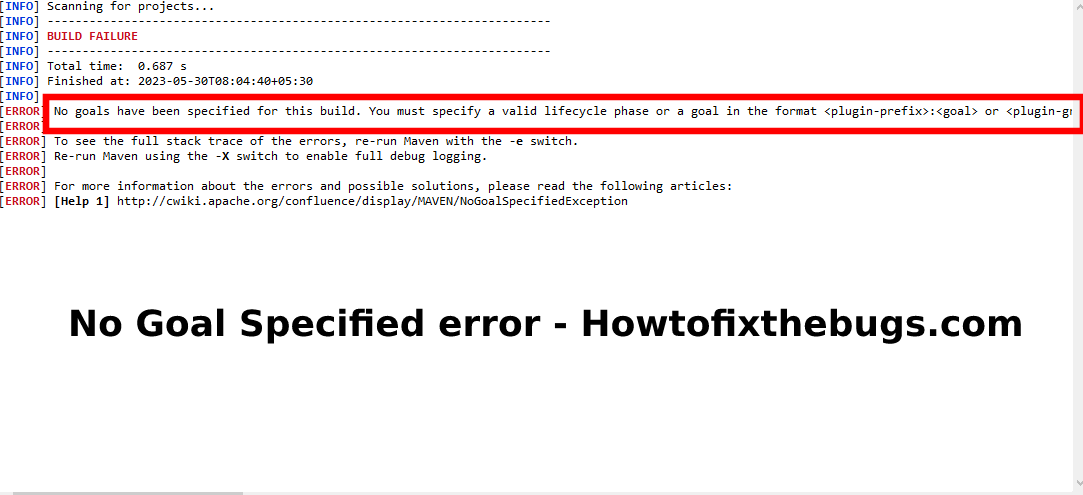Maven error no goal specified
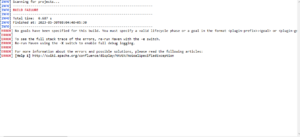
Introduction:
Maven, a popular build automation tool used primarily for Java projects, has revolutionized the way developers manage dependencies and build their applications. However, like any software tool, it is not exempt from occasional errors and glitches. One such error that can puzzle developers is the infamous “No Goal Specified” error. In this blog post, we will dive into the details of this error, understand its causes, and explore potential solutions to resolve it.
Spring Boot, a popular framework for building Java applications, streamlines the development process by providing out-of-the-box configurations and conventions. However, developers may encounter various errors while working with Spring Boot projects, one of them being the puzzling “No Goal Specified” error. In this blog post, we will unravel the causes behind this error and explore effective solutions to overcome it in the context of Spring Boot projects.
Understanding the “no goal specified” Error:
When using Maven or Gradle as the build tools in a Spring Boot project, the “No Goal Specified” error may occur when executing commands without specifying a valid goal or task for the build tool to perform. Both Maven and Gradle rely on goals or tasks to execute specific actions, such as compiling the code, running tests, or creating executable files.
Causes of the no goal specified Error:
- Missing or Incorrect Command: The most common cause of the “no goal specified” error is omitting the goal itself when running a Maven command. For example, entering only the command “mvn” without specifying any goals will trigger this error.
- Incorrect Syntax: Another reason for this error could be incorrect syntax in the Maven command. Maven commands follow a specific structure, and a mistake in the syntax can confuse Maven and result in the “no goal specified” error.
- Project Structure Issues: If there are issues with the project structure or the Maven configuration, such as a missing or corrupted POM (Project Object Model) file, it can lead to the error. Maven relies heavily on the POM file to understand the project’s structure, dependencies, and build settings.
- Omitted Command: The most common cause of the “No Goal Specified” error in a Spring Boot project is forgetting to include the build tool command altogether. For instance, running “mvn” or “gradle” without any additional parameters will trigger this error.
- Incorrect Command Structure: Improper syntax or command structure can also result in the “No Goal Specified” error. Ensure that you follow the correct syntax for your chosen build tool and specify the necessary goals or tasks to execute.
- Misconfigured or Missing POM/Build Files: If the project’s POM file (for Maven) or build.gradle file (for Gradle) is missing, incorrectly configured, or corrupted, the build tool may not be able to determine the appropriate goals or tasks to execute. This can lead to the “No Goal Specified” error.
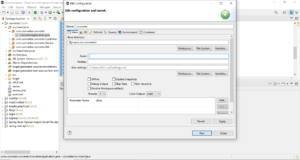
Solutions to Resolve the No Goal Specified Error:
- Specify a Valid Goal or Task: Ensure that you include a valid goal or task when running the build command. For example, use “mvn clean install” or “gradle build” to compile the code, run tests, and create the project’s artifacts.
- Review Command Syntax: Double-check the syntax of your build tool command. Make sure you have included the necessary parameters, such as the build tool’s name (e.g., “mvn” or “gradle”) and the desired goal or task to be executed.
- Verify POM/Build File Integrity: Check that the POM file (for Maven) or build.gradle file (for Gradle) is present in the project’s root directory. Ensure that the file is properly configured and contains the required information for the build tool to perform the desired actions.
- Clean and Rebuild the Project: If the error persists, try cleaning the project by running the appropriate command, such as “mvn clean” or “gradle clean.” This will remove any existing build artifacts. Afterward, execute the desired build command to rebuild the project.
- Update Build Tool Versions: Keeping your build tools up to date is essential. Check if there are any updates available for Maven or Gradle and upgrade to the latest stable version. Upgrading can often resolve known issues and improve compatibility with your Spring Boot project.
Still you are not able to fix the “No Goal Specified ” error and failed to run the springboot project, then follow the below step.
Steps to fix the “No Goal Specified Error”
Steps: 1. go to Run->Run configuration -> Maven Build -> New configuration
Steps: 2. set base directory of you project ie.${workspace_loc:/lbi-be-war}
Steps: 3. set goal spring-boot:run
Steps: 4. Run project from Run->New_Configuration
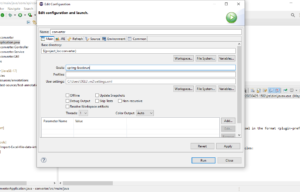
After these setting your springboot will run successfully and resolved your no goal specified error
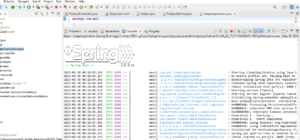
This method is tested and working you can check its stackoverflow solution for no goal specified error.
Conclusion: Encountering the “No Goal Specified” error while working on a Spring Boot project can be confusing, but understanding its causes and implementing the appropriate solutions can swiftly resolve the issue. By ensuring that you specify a valid goal or task, reviewing the command syntax, verifying the integrity of your POM or build files, performing a clean build, and keeping your build tools updated, you can overcome this error and continue developing your Spring Boot applications seamlessly.
Spring Boot provides a robust and efficient framework for Java development, and familiarizing yourself with common errors like this will
#Howtofixthebugs.com
##No goals have been specified for this build. You must specify a valid lifecycle phase or a goal in the format <plugin-prefix>:<goal> or <plugin-group-id>:<plugin-artifact-id>[:<plugin-version>]:<goal>. Available lifecycle phases are: validate, initialize, generate-sources, process-sources, generate-resources, process-resources, compile, process-classes, generate-test-sources, process-test-sources, generate-test-resources, process-test-resources, test-compile, process-test-classes, test, prepare-package, package, pre-integration-test, integration-test, post-integration-test, verify, install, deploy, pre-clean, clean, post-clean, pre-site, site, post-site, site-deploy.

